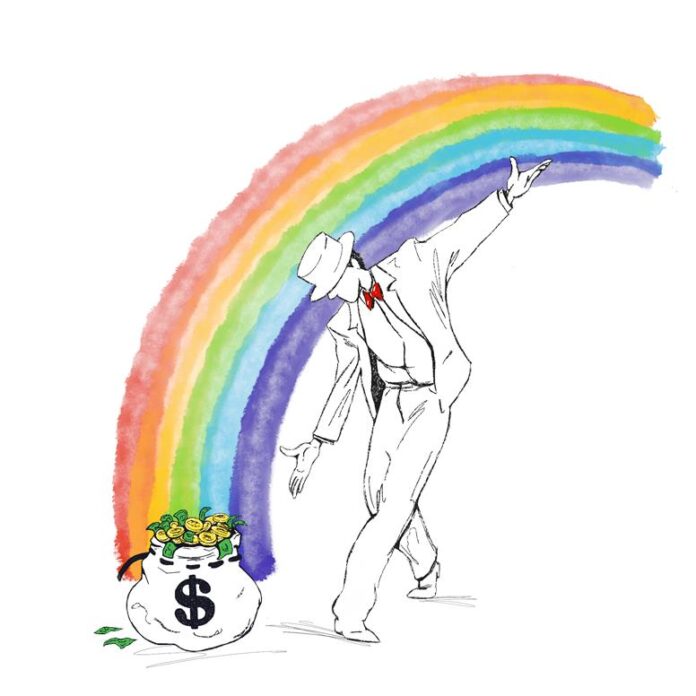It’s Pride Month again, and you know what that means. Walmart and Target are rolling out their annual barrage of tacky Pride merch, corporations are swapping out their Twitter profile pictures for rainbow-striped alternates, and Skittles are gay once again. At first glance, this seems like good news. After all, there’s no denying that such ubiquitous support for Pride from some of the most powerful companies in the world is a major victory. It’s hopefully a sign that those of us with differing sexual orientations and gender identities are becoming a “normal” fixture of everyday life. But when I see what corporate Pride actually looks like, I can’t help but notice how hollow this victory feels.
It’s a bitter fact that most large corporations are only willing to go so far when it comes to showing their support. We all know why Pfizer Inc. and Pfizer Canada have donned the rainbow on Twitter, yet Pfizer Saudi Arabia has not. Why risk angering your consumer base in a country where homosexuals are major targets of religious and political persecution? Target recently withdrew some Pride Month merchandise after receiving threats from angered customers. Endorsing Pride puts these companies into uncomfortable situations — either go all-in and potentially put employees (and profits) at risk, or give into intimidation and rescind your allyship. Damned if you do, damned if you don’t.
So why does seemingly every business feel the need to show their rainbow stripes every summer? Corporations aren’t activist organizations, and have no obligation to visibly support Pride. But if they can make a couple bucks by slapping rainbows on their products and selling them in an LGBTQ+ friendly market, they surely will. Plus, they’ll also garner praise and favourable press along the way. This kind of shallow corporate allyship has become so prominent in recent years that it has a name: “rainbow capitalism.” It’s not always done in bad faith — and spreading awareness isn’t a bad thing — but oftentimes, “awareness” tends to overshadow the need for actual activism.
At the heart of “rainbow capitalism” is the rainbow itself, a symbol with a fascinating history. Conceived in 1978 by Gilbert Baker, the flag originally had eight colors and was intended to unite the LGBTQ+ community under a single banner. The colored stripes were not meant to symbolize the various communities under the LGBTQ+ umbrella; they each represented different aspects of human existence (sex, nature, art, etc.). By 1979 the flag had evolved into the familiar six-striped design we tend to see today, but the meaning was still radically clear: no matter your identity, the rainbow emphasizes the importance of your humanity.
Baker’s flag was extremely influential, and in the years since, countless Pride flag variants have sprung up. In 2018, Seattle’s LGBTQ Commission combined two pre-existing flags: Amber Hikes’ rainbow flag (featuring brown and black stripes to represent queer people of color) and Monica Helms’ transgender Pride flag, creating a massive 11-stripe flag. The newly added stripes were reshaped into an arrow by Daniel Quasar, forming the “Progress Pride Flag.” It’s possibly the most widely-used variant today, flown everywhere from shop windows to city skylines to the White House. Quasar has expressed concerns about corporate misuse of the flag without consulting or giving back to the LGBTQ+ community — rainbow capitalism at its finest.
There are a few post-Quasar designs that have surged in popularity since 2018. There’s an intersex-inclusive design, and a “red umbrella” design intended to represent queer sex workers. There’s nothing wrong with these variants existing (although in my humble and purely vexillological opinion, everything post-Baker has been kind of ugly). They highlight the needs of underrepresented and marginalized communities. However, the widespread corporate adoption of these flags has turned into a dick-measuring contest — if you don’t have the latest Pride flag hanging in your store, you simply aren’t being progressive enough. Most businesses have updated their standard Pride flags to the Quasar arrow and intersex circle variant by now.
This has created the misconception that these increasingly complex variants have somehow been unanimously decided to be the “new Pride flag” by the LGBTQ+ community. In reality, these designs are typically created by independent artists and make no claim to be the “definitive” symbol of Pride, yet corporate appropriation pushes them to the forefront of popular culture. Flag discourse begins; people become angry that the “new flag” is needlessly inclusive, or that it’s not inclusive enough. Why does the transgender community get three whole stripes while other communities get nothing? All of this debate over inclusion and representation on the flag misses the point of the original rainbow flag: no one is being left out, because everyone is automatically included.
Pride Month is slowly but surely becoming a wholly commercialized season, much like Christmas or Halloween. Every June, companies will be able to sell rainbow-coloured kitsch and hopefully expect an uptick in profits. If consumers push back, some companies may decide to give in, and discreetly remove anything overtly gay from their stores and websites. In both cases, actual corporate activism will almost certainly decline. Most companies will take the path of least resistance, and it will be considered good enough to put up some committee-approved Pride flags and call it a day. The revolutionary and unitary power of the original rainbow has diminished since 1978, and I fear that the flag in its place feels more like a corporate logo that is constantly being rebranded, rather than a call to action.
Matthew Iddon was born at an exceptionally young age. He aspires to one day become old. He currently resides.



